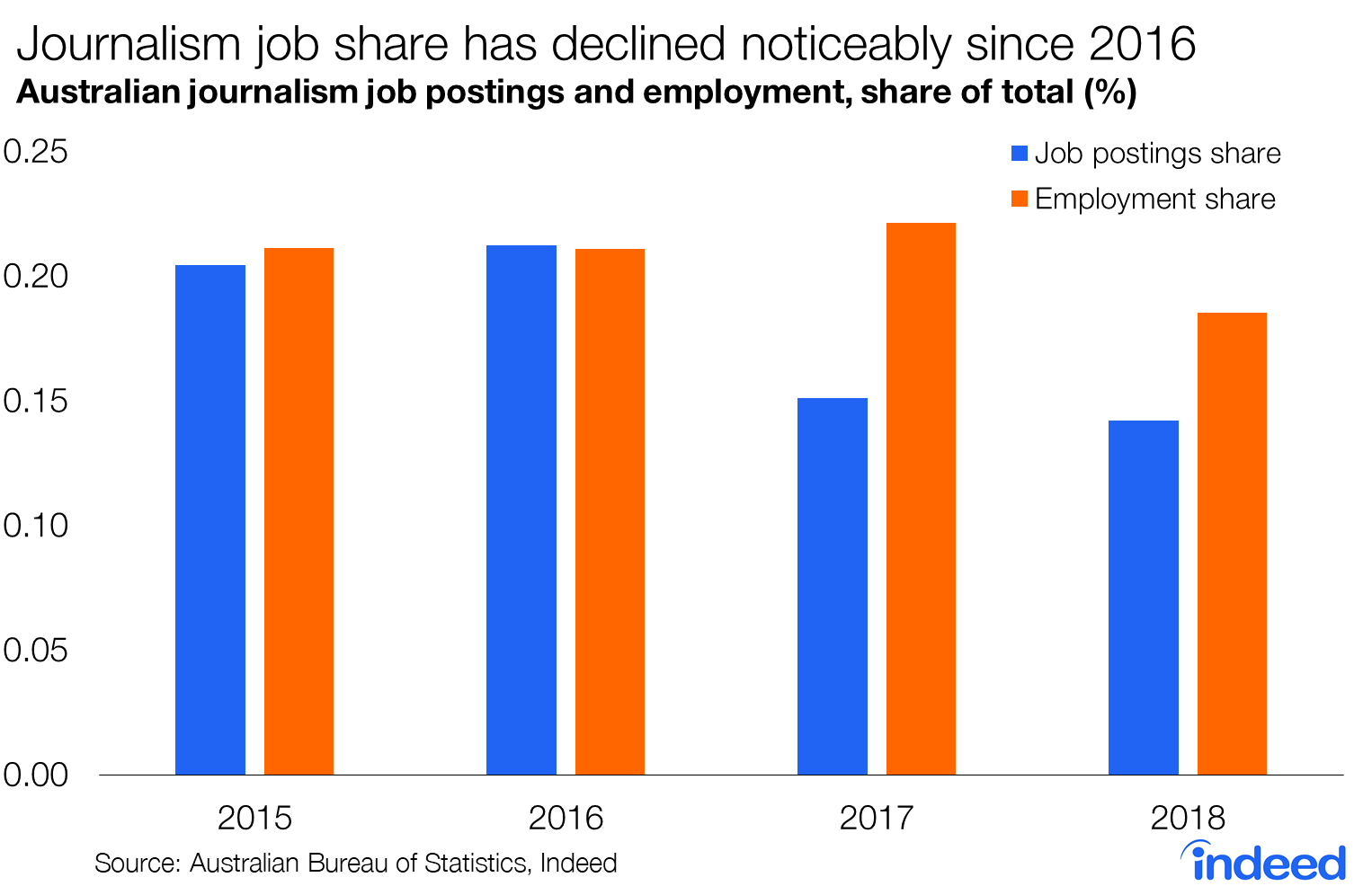Key points:
- Journalism jobs as a share of total employment have held relatively steady over the past three decades despite tremendous industry upheaval.
- However, new journalism opportunities have dried up recently in an apparent sign that the industry may be contracting.
- New South Wales remains the best destination for finding journalism employment, mainly because of a concentration of jobs in the field in Sydney.
We often hear dire predictions of journalism’s imminent doom. Yet, Australian employment in journalism has held up well over the past three decades. That might be a surprise to some given the gloom surrounding the industry. Journalism has become increasingly concentrated, dominated by a few publishers, and industry job losses tend to receive extensive media coverage.
This is not new. Australian journalism has appeared to be on the verge of collapse for years. Now though, if Indeed’s research is any guide, that meltdown may finally happen. Despite the fact that industry employment has held up reasonably well so far, the number of new opportunities has taken a nosedive. Although this is not the first time that new journalism positions have dried up, the trend does point towards a fall in industry employment going.
Of course, the job totals don’t tell the whole story of the demise of Australian journalism. The decline is also reflected in salaries and job security, the increasing reliance on interns and freelancers, and publisher consolidation due to mergers and closures. The industry has undergone almost unprecedented change over the past two decades. Job opportunities are just one piece of a much larger puzzle.
For journalists, new opportunities are few and far between
Journalism currently accounts for a minuscule 0.19% of the Australian workforce. In such a small sector, employment can be volatile, as the sharp rise and subsequent decline in 2012 and 2013 show. But, despite ominous signs, overall, employment in the industry has generally kept pace with the broader economy over the past 30 years. Journalism’s employment share today is only slightly below where it was in the 1980s and 1990s.

Nevertheless, today’s concern is widespread over the future of journalism in Australia and many fear the ax will finally fall on industry jobs. This was most recently captured by BuzzFeed’s stunning decision to cut almost every Australian journalist from its news team. And the warning signs are readily apparent in Indeed job postings data, both in Australia and the United States.
The journalism job market has noticeably deteriorated recently. In the first two months of 2019, journalism’s share of total job postings was 30% lower than in the same period last year. And journalism’s posting share on Indeed had already fallen 33% in 2018 compared with two years earlier.
These trends suggest that journalism employment is poised to fall. When job postings drop, as they have recently, we would expect employment to eventually follow suit. Thus, a sharp drop in postings share in 2017 may have triggered a decline in employment share in 2018.

While job opportunities for journalists have declined across the board, the falls have been more pronounced in some occupational groups than in others. The job posting share for reporters and correspondents has plunged 41% since 2016, while the shares for broadcast news analysts and editors are down 17% and 28% respectively. The start of 2019 has been especially rough for all three groups, with their postings shares well down from the same period last year.

Opportunities for journalists are heavily concentrated in New South Wales
While opportunities are sparse everywhere, journalism job seekers had better be prepared to live in Sydney. New South Wales, primarily Sydney, accounts for almost half of all journalism job postings, with Victoria at 21% and Queensland at 14% far behind.
Unsurprisingly, Canberra punches well above its weight, with journalism jobs accounting for 0.23% of postings in the ACT—almost 70% higher than in Australia’s other states and territories. In fact, over the past two years, journalism’s share of job postings has declined everywhere but in the ACT. In New South Wales, journalism accounts for 0.19% of all state job postings, down from 0.25% two years ago. Victoria has experienced an even larger decline. Both states have experienced strong overall job growth, underscoring journalism’s weakness.

All things considered, Australian journalism employment has held up reasonably well in a challenging environment over the past two decades. Until now, the industry’s troubles have mainly affected journalists through declining salaries and job security rather than a decline in the total number of jobs. But this relatively stable employment share may be on the verge of ending.
Unfortunately, journalism opportunities are disappearing. While this isn’t the first time industry conditions have been dark, every journalist in the country would be forgiven for wondering whether this is finally the end of the road for Australian journalism as we have known it. Only time will tell whether the sector will bounce back, once again adapting to its ever-changing environment. What we can say with some assurance is that 2019 appears likely to be a tough year for Australian journalism, with limited opportunities for those trying to break in or find themselves a new gig.
